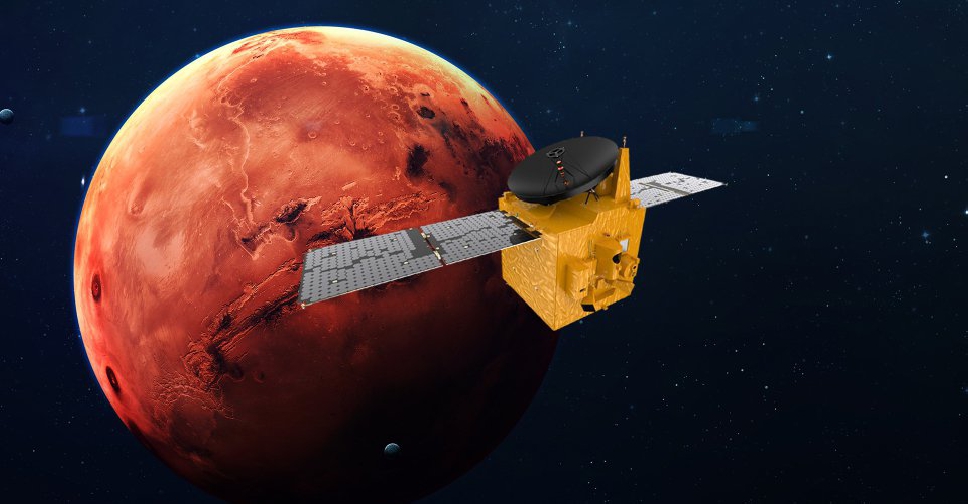
The UAE’s Hope probe has discovered a new type of proton aurora around Mars.
Aurorae are ultraviolet lights that appear on the planet when solar activity disturbs the atmosphere.
The ‘patchy’ proton aurora potentially triggers new insights into unexpected behaviours in the Martian atmosphere.
The Emirates Mars Mission team has worked together with NASA’s MAVEN (Mars Atmosphere and Volatile Evolution) mission to fully characterise these observations.
The Emirates Mar Mission (Hope Probe) has made first observations of a new type of proton aurora near Mars. The 'patchy' proton aurora could provide new insights into unexpected behaviors in the Martian atmosphere. pic.twitter.com/JmWRHpoHQc
— Hope Mars Mission (@HopeMarsMission) August 31, 2022
"Our discovery of this patchy proton aurora adds a new kind of event to the long list of those currently studied by EMM and challenges our existing views of how the proton aurora on Mars’ dayside are formed," said Hessa Al Matroushi, EMM’s Science Lead.
"The EMM Hope probe has so far uncovered many unexpected phenomena that extend our understanding of Mars’ atmospheric and magnetospheric dynamics. These new observations, combined with MAVEN data, have lifted the lid on entirely new possibilities for scientific research."
This new patchy type of proton aurora is formed when the solar wind directly impacts Mars’ dayside upper atmosphere and emits ultraviolet light as it slows down.
It was discovered in snapshots of the dayside disk obtained by the Emirates Mars Ultraviolet Spectrometer (EMUS), which observes the planet’s upper atmosphere and exosphere, scanning for variability in atmospheric composition and atmospheric escape to space.
The aurora manifests as bright regions scattered across the dayside of the planet in two ultraviolet wavelengths associated with the Hydrogen atom, Lyman beta at 102.6 nm and Lyman alpha at 121.6 nm. Under normal conditions, the dayside disk of the planet at these wavelengths is uniform, and the planetary brightness results from Hydrogen atoms scattering sunlight. When the aurora occurs, small regions of the planet become much brighter at these wavelengths, signifying intense localised energy deposition in the atmosphere.



 Dubai to honour food outlets for excellence in safety, nutrition
Dubai to honour food outlets for excellence in safety, nutrition
 UAE stresses importance of Gaza ceasefire
UAE stresses importance of Gaza ceasefire
 UAE, US discuss strengthening defence partnership
UAE, US discuss strengthening defence partnership
 RTA confirms intercity bus service returns to normal
RTA confirms intercity bus service returns to normal
 DXB returns to normal operations
DXB returns to normal operations
 Funeral prayer held for Sheikh Tahnoun bin Mohammed
Funeral prayer held for Sheikh Tahnoun bin Mohammed
 Dubai to open new bus station, improve several routes
Dubai to open new bus station, improve several routes
 UAE President mourns passing of Sheikh Tahnoun bin Mohammed
UAE President mourns passing of Sheikh Tahnoun bin Mohammed
 UAE sends 12 aid trucks to Gaza Strip
UAE sends 12 aid trucks to Gaza Strip
 Dubai airports cancels, diverts flights due to heavy rain
Dubai airports cancels, diverts flights due to heavy rain
 Heavy rain, thunder and lightning hits parts of UAE
Heavy rain, thunder and lightning hits parts of UAE
 Emirates cancels flights due to bad weather
Emirates cancels flights due to bad weather
 Dubai property developers told to provide support during unstable weather
Dubai property developers told to provide support during unstable weather
 RTA issues safety guidelines for driving in heavy rain
RTA issues safety guidelines for driving in heavy rain
 UAE, Egypt carry out 43rd airdrop in Gaza
UAE, Egypt carry out 43rd airdrop in Gaza
 Dubai Government announces remote work
Dubai Government announces remote work
 Abu Dhabi activates distance learning, remote work
Abu Dhabi activates distance learning, remote work
 UAE private firms urged to apply flexible work patterns
UAE private firms urged to apply flexible work patterns
 Remote work declared for federal government staff
Remote work declared for federal government staff
 NCEMA recommends governments implement 2-day remote work
NCEMA recommends governments implement 2-day remote work
